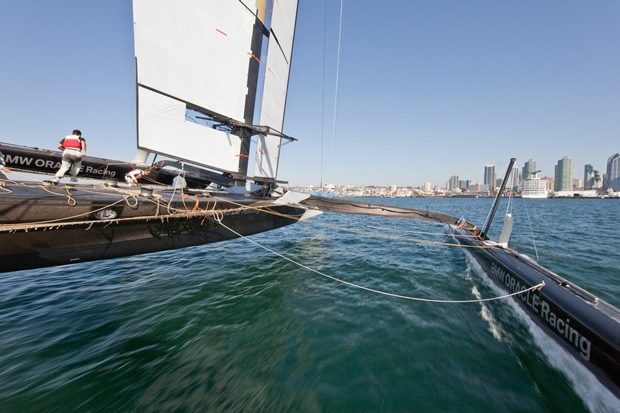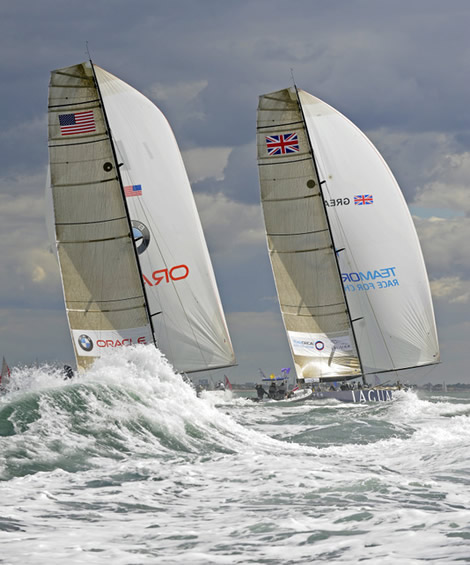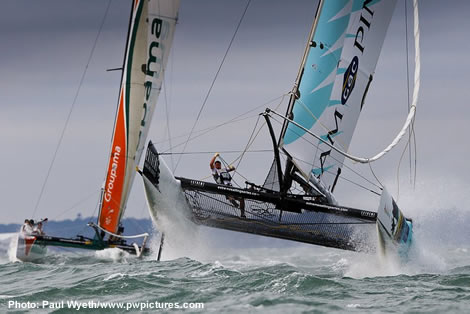
Latest America's Cup 34 views
Russell Coutts was in Cowes on Thursday and, as a press release from BMW Oracle Racing indicates, he was in town not so much for the 1851 Cup between TeamOrigin and his own team, but to discuss the 34th America’s Cup with the Extreme 40 class. Decisions over the 34th America’s Cup are coming up fast and if it does go multihull with a 22m (72ft) solid wingsail catamaran, the basic concept of which has already been proposed alongside the draft Protocol, then the Extreme 40 class will certainly be a strong lobby in its favour. In fact when it comes to Coutts’ vision for the 34th America’s Cup, his philosophy is most closely aligned with the Extreme 40 class, not only the high performance catamarans its uses, but also the whole Extreme Sailing Series concept of mass-popularising the sport, only raised to a whole new level. We caught up with Coutts briefly and informally yesterday afternoon and he was enthusing about some of the television technology that they are looking to harness for the 34th America’s Cup. Some of this, including a tethered blimp fitted with a camera and huge lens, were being trialled this week at the 1851 Cup, but there is a considerable amount of work going on behind the scenes into overlaying television images with explanatory graphics, something that has been done previously in post-production but never fully realised live, in real time. We helpfully put it to Coutts that in our opinion singularly the greatest shortcoming of live television coverage of yacht racing, particularly when it involves the complexities of match racing, is how ridiculously slow it is to get 100% accurate information back from on the water, whether it is about incidents or umpire calls. This has been apparent this week at the 1851 Cup (although today was good with our Yachting World colleague Matt Sheahan on the umpire boat when TeamOrigin picked up a penalty for ‘dissent’), but has also been true even in top league regattas such as past America’s Cups. What is needed are people with communication skills placed aboard both jury boats and race boats and a constant reliable live link to shore from them. This, together with decent audio coming back from the race boat crews, we felt, was perhaps even more important than ‘revolutionising’ video images of the boats or pictures coming back from on board. However in his reply Coutts roundly trumped us on all fronts. For some of the ideas they are coming up with for the union between the real and ‘virtual’ worlds and tracking, etc are set to take this technology way beyond anything we have previously seen. With a combination of the latest generation GPS-based tracking and the number of cameras pointing at the action, both on board and off, then Coutts is of the opinion that umpiring in the future could almost take place in the studio ashore. He provided the analogy with tennis where any queries about line calls are decided from looking at the graphics with players allowed a maximum of three queries per match. The actual on-court umpire is almost redundant. At present sailing perhaps looks as silly as football does for not having fully embraced this technology as a matter of course. This kind of technology has additional implications when it comes to course management. For example there should be no reason why a weather mark or leeward gate should be off station and it doesn’t take a huge leap in imagination to see that debatable OCS calls might become a thing of the past. In terms of the sound and vision from the recent trials in Valencia, Coutts said he thought the greatest success were the trials with the surround sound coming off the boats that perfectly captured ‘the noise’, the creaking and groaning of the boat, the sound of waves on hull, that to date you never really pick up from on board audio. Change of course Interesting developments are also being looked at in terms of the courses. A strong idea for example is replacing the traditional inflatable marks with boats or barges fitted with seating (and ideally a bar), where spectators can view the action up close. This is a development of the inflatable paddling pool-style mark, trialled by Louis Vuitton’s Bruno Trouble during the Acts leading up to the 32nd America’s Cup. Alternative course formats are also being investigated to maximise passing opportunities by, for example, having a short beat followed by the downwind leg. Rather than having the full race course as a giant diamond defined by the starboard and port tack laylines into the weather mark and leeward gates, Coutts is also looking at chopping off the sides of the diamond, narrowing the race track. This would prevent boats becoming 1km or more apart as occasionally we have seen in past America’s Cup matches and would also prompt the boats to carry out more manoeuvres. With the LV Trophy on hold now in 2011, Coutts is also considering what can replace it as he seems to have no interest in continuing any form of racing in Version 5 ACC boats (very 1990s). An option being considered, we understand, is some sort of one design and if BMW Oracle Racing is erring towards multihulls then one imagines that a 2011 version of the Extreme 40, perhaps with a solid wingsail, might be the weapon of choice. Coutts and the Extreme 40s Those who attended Thursday’s Extreme 40 meeting with Coutts included ex-Alinghi shotgun helmsman Loick Peyron, OC CEO Mark Turner and Extreme 40 circuit manager Gilles Chiorri, as well as Paul Campbell-James and Extreme 40 circuit creators Mitch Booth and Herbert Dercksen. “I would say he has a great vision and full commitment to changing the direction of our sport, I think for the better,” commented Mitch Booth after the meeting. Herbert Dercksen has always been uncompromising when it comes to the merits of catamarans and he is entirely aligned with Coutts’ vision, having been the principle architect of the Extreme 40 class. At present he is looking to build a solid wing sail for his 20ft catamaran, the Round Texel record holder. “It was great to see a man of that calibre is open minded and with financial backing there that is potentially great for the future of catamarans and to change the sailing world,” commented Dercksen of yesterday’s meeting. If Coutts does come up with a one design multihull as a stop gap between now and the time Cup teams launch their new boats in the spring of 2012, then Dercksen says it could also make a good class from which teams and sailors could graduate up to the America’s Cup, a relationship similar to that in motor racing between GP2 and Formula 1. Dercksen says it is interesting how since the 33rd America’s Cup both the BMW Oracle Racing and Alinghi teams are now multihull converts (in fact Ernesto Bertarelli has been racing them on Lake Geneva for almost two decades). “They weren’t really into catamarans before, but they have learned how to sail them and now they find it is actually a much more fun boat to sail,” Dercksen says of BMW Oracle Racing. However he makes the astute observation that within the America’s Cup community all the teams are batting for what they know they are good at. “Everyone is working for their own benefit and everyone is looking for their best starting position. If you go monohull, then it is all the same people it used to be and all the existing teams will have a good head start.” Dercksen also reckons that whatever boat BMW Oracle Racing chooses, monohull or multihull, the people who now say they won’t take part, still will. “One thing I have learned with the Extreme 40s - I have had so many sailors complaining to me that ‘its not racing, its not real’ and all the big guys were saying the Extreme 40 can’t be good. But at the end of the day the best are winning and I don’t know – in 25 knots racing with the Extreme 40s it is a spectacle – ‘action, attraction, addiction’ and that’s what sailing should be all about.” While he is building a wing for himself and has the ultimate aim of competing in the Little America’s Cup, Dercksen wasn’t sure a solid wing sail should be used for a European or Global circuit. “That was my question – what is the cost of a wing compared to the cost of sails”: there is not much difference because the wear and tear on the sails goes pretty quick, while the wear and tear on the wing is a lot less. And if they capsize with the wing it is more spectacular..!” Dercksen pointed out that Cowes this week has provided a unique opportunity to see the new – the Extreme Sailing Series – and the old – the 1851 Cup, the V5 America’s Cup Class leadmines and his nimble 40ft high performance catamarans. Photo: Rick Tomlinson/www.rick-tomlinson.com One observation in particular was the comparison between America, the famous ship that won the 100 Guineas Cup (latterly the America’s Cup) 159 years ago and a Version 5 ACC boat as being used at the 1851 Cup and for the America’s Cup in Valencia in 2007. The 1851 America was 30.9m LOA compared to the ACC boat’s 24 and had a 7m beam, twice as much as the slender ACC boats. The biggest difference was the displacement,America weighing a hefty 170 tonnes, while the ACC boats are a still heavy by today’s standards 24. The typical speed of America? 12 knots. And of an ACC boat? Er – 12 knots. Given that 159 years has passed and this intervening period has seen the complete history of development of the motor car and the microchip computer, this hardly seems like progress our sport should be proud of. James Spithill When we spoke to BMW Oracle Racing skipper James Spithill about his view on the choice of a multihull or monohull weapon for the 34th America’s Cup he told us: “I am happy either way. We are talking to a lot of people. What I want is something spectacular for the future of the sport - we have to get the commercial side right with the TV and we have to get new kids into the sport. It is not about the older generation – it is about the next generation. We are going to make sure we speak to everyone before making the decision.” While Spithill reels off the team line when it comes to the 34th America’s Cup, he is clearly a multihull convert. Recently he competed with A-Class World Champion Glenn Ashby at the F18 catamaran Worlds and was to have raced in the Round Texel, except it was cancelled due to there being too much wind. However towards the end of this month he is heading out to Newport, RI for the Little America’s Cup. “I can’t wait - I have been looking forward to it all year. To me that is an exciting side of the sport.” And it seems likely that, as has been the case in the F18, Spithill, one of the world’s greatest helmsmen, is likely to be on the wire! “Glenn said that I should steer but to be honest I’d rather let him drive. The last few regattas in the Formula 18s I have crewed and it would be cool for him to do some of the match racing.” Challenger participation During his visit yesterday Coutts also met with TeamOrigin’s Sir Keith Mills and Grant Simmer to discuss in particular challenger involvement in the 34th America’s Cup. “It was really constructive,” Sir Keith Mills told thedailysail. “Some of the plans Oracle are working on are very exciting and we told Russell that we were very supportive of all the initiatives and in particular the TV initiatives and we told him we expected the defender to deliver to the challengers a set of rules, a protocol and a class of boat that enables all the challengers to have a fair crack of the whip on a level playing field. He confirmed to us that was their intention too. “But the proof of the pie is in the eating. The final Protocol and class rules haven’t been set yet. They will in the next couple of months. Russell invited us to work with his team on the detail to make sure that the end result is what we all want. “We definitely feel more included in the process but it has to be more than one meeting and it can’t be a token effort. The feeling Grant Simmer and I had was that it was a very positive step in the right direction. They are listening to what we have to say and we are optimistic that we will get the fair and level playing field that we need.” According to Sir Keith Mills, Coutts invited TeamOrigin to work with the other challengers and to feed back their input directly to BMW Oracle Racing (interestingly not via the Challenger of Record). Obviously all of the above is still very much in the BMW Oracle Racing melting pot and decisions will be made in the next few weeks. But if we were to place bets, we suspect that given how he was unable to get his way with Ernesto Bertarelli over the 32nd America’s Cup event, it is unlikely that Coutts will be strayed from achieving his objective with the 34th. As we said in another article on this subject recently the issue with the challengers, aside from the fact that they don’t want to race the America’s Cup in multihulls, and nor do they want canting keel monohulls (the two options BMW Oracle Racing are offering), is more to do with the solid wing sail, where clearly following their R&D work on the 33rd AC, BMW Oracle Racing holds an advantage over the challengers. If it were to go to more conventionally rigged catamarans, then perhaps this would be an acceptable compromise and even the playing field being referred to? At the end of the day the acid test to achieve Coutts’ vision is: what type of boat is more likely to prise a 10 year old from their X-Box? A V5 ACC boat doing 12 knots, a canting keel TP52-type boat blasting along at 30 knots or a catamaran doing 40 knots with one hull in the air? You do the math. As one observer put it to us wryly, if you're going to stick with heavy boats for the America's Cup, then why not just revert to the J-Class?









Latest Comments
Blackburn 19/08/2010 - 15:42
Highlighting comments is an improvement, no sweat! Not that I take even the gospel as gospel, and Montgomery is capable of spin. But Rome harboring cats? Who has ever heard of such a thing? .... http://www.netflix.com/Movie/Cats_of_Rome/70091482 http://goeurope.about.com/cs/rome/a/rome_cats.htmJames Boyd 19/08/2010 - 10:46
Thanks - did spot this and rumour exchange is stating Rome in solid wingsail cats but until we hear something categoric from our friends in San Fran don't take anything as the gospel... even from the eminent Montcommentry. And apologises for are rejigging the forum area. We launched this prematurely and instead will be focussing on these comments.Blackburn 19/08/2010 - 02:01
No sooner do I return from summer vacation (It was hot and delightful, thanks for asking), than I find there's been a housecleaning here at TDS where all the nasty gossip has been chucked out! Here's some more, regardless; an intriguing blend of fact and fantasy...? http://www.radiosport.co.nz/SportsNews/spyac/Detail.aspx?id=180821 http://www.stuff.co.nz/sunday-star-times/sport/latest-sport/4040599/Orac...Add a comment - Members log in